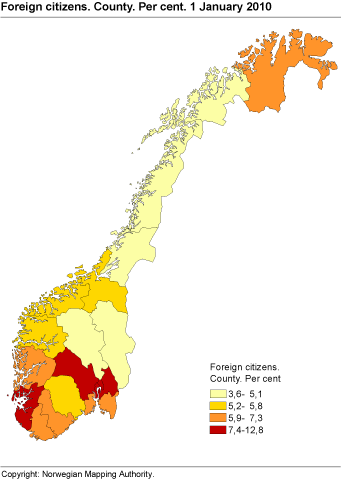Content
Published:
This is an archived release.
333 900 foreign citizens
At the beginning of this year, the number of foreign citizens in Norway was 333 900, which is 6.9 per cent of the population. The increase in foreign citizens in 2009 was 31 000. Polish citizens constitute the largest group of foreign citizens in Norway, followed by the Swedish, and German citizens have now surpassed Danish as the third largest group.
Two in three are European
Sixty-six per cent of all foreign citizens in Norway have European citizenship, 19 per cent have Asian citizenship and 9 per cent have Africa citizenship. Seventy-five per cent of the increase in the number of foreign citizens was due to Europeans. The 5 300 Icelandic citizens living in Norway – 1.7 per cent of the population of Iceland – would correspond to 82 600 Norwegian citizens living in for example Denmark.
Migration and granting of Norwegian citizenship affect the number of foreign citizens. A person is normally granted Norwegian citizenship after a certain length of residence. Since the mid-1980s, a large majority of those who have applied for and have been granted Norwegian citizenship have been non-European citizens. The majority of immigrants from Vietnam are Norwegian citizens, whereas only a small share of those who have migrated from Sweden have changed citizenship.
Polish citizens are the largest group
As in every year since 2004, the number of Polish citizens increased the most last year. The 46 700 Polish citizens in Norway make up the largest group of foreign citizens, and their number increased by 7 500 last year. The 35 800 Swedish citizens are the second largest group, whereas German citizens (20 800) during 2009 surpassed Danish citizens (20 700) as the third largest group. The groups with the largest increase were Polish, Swedish, Lithuanian, German and Eritrean citizens. A few groups had a decrease, the largest of which was among the Iranian citizens (300 fewer than last year).
Where in Norway do foreign citizens live?
Oslo, Rogaland and Akershus counties have the highest numbers of foreign citizens. In these counties foreign citizens make up 13 (Oslo) and 8 per cent of the population respectively. Forty-five per cent of all foreign citizens in Norway live in these three counties. The county with the smallest amount of foreign citizens is Nord-Trøndelag.
Sex and age – large differences between the groups
There are considerable differences in the sex and age structure of various groups of foreign citizens. Of the Greek, Polish and Slovakian citizens, 70 per cent are men. Among the Thai and Filipino citizens, on the other hand, only 15 to 18 per cent are men. Whereas 36 per cent of African citizens are below 20 years of age, only 10 per cent of North or Central American citizens are in this age group.
Whereas one in three from North or Central America are 50 years or over, this only applies to 4 per cent of African citizens.
On 1 January 2009 the Marriage Act was changed in such a way that two persons of the same sex can be married, and new partnerships were abolished. Persons already in a partnership can change their partnership to a marriage, or continue their partnership. The reason there were 1 466 fewer registered partnerships on 1 January 2010 compared to 2009 is due to the new Marriage Act and the fact that many did change their partnership to a marriage.
Tables
- Table 1 Population, by age and county. Absolute figures. 1 January 2010
- Table 2 Population, by age and county. 1 January 2010. Per cent
-
Population, by sex, age and municipality. 1 January 2010
- Table 3 Østfold
- Table 4 Akershus
- Table 5 Oslo
- Table 6 Hedmark
- Table 7 Oppland
- Table 8 Buskerud
- Table 9 Vestfold
- Table 10 Telemark
- Table 11 Aust-Agder
- Table 12 Vest-Agder
- Table 13 Rogaland
- Table 14 Hordaland
- Table 15 Sogn og Fjordane
- Table 16 Møre og Romsdal
- Table 17 Sør-Trøndelag
- Table 18 Nord-Trøndelag
- Table 19 Nordland
- Table 20 Troms Romsa
- Table 21 Finnmark Finnmárku
- Table 22 Population, by sex and age. Oslo. Urban district. 1 January 2010
- Table 23 Population, by age. Oslo. Urban district. 1 January 2010. Per cent
- Table 24 Population, by sex and age. Bergen. Urban district. 1 January 2010
- Table 25 Population, by age. Bergen. Urban district. 1 January 2010. Per cent
- Table 26 Population, by sex and age. Stavanger. Urban district. 1 January 2010
- Table 27 Population, by age. Stavanger. Urban district. 1 January 2010. Per cent
- Table 28 Population, by sex and age. Trondheim. Urban district. 1 January 2010
- Table 29 Population, by age. Trondheim. Urban district. 1 January 2010. Per cent
- Table 30 Population, by marital status, sex and age. 1 January 2010
- Table 31 Foreign citizens. Number and as a percentage of population, by county. 1 January 1976-2010
- Table 32 Foreign citizens, by citizenship, sex and age. 1 January 2010 [Corrected 4 March 2011]
- Table 33 Foreign citizens, by citizenship per 1 January 1975-2010
- Table 34 Population by sex, age and marital status. 1 January 2010
- Population, by sex and one year age groups. 1 January 1986 - 2010 (Statbank)
Contact
-
Magnus Haug
E-mail: magnus.haug@ssb.no
tel.: (+47) 40 81 14 91
-
Karstein Sørlien
E-mail: karstein.sorlien@ssb.no
tel.: (+47) 47 70 16 35
-
Linn Krokedal
E-mail: linn.krokedal@ssb.no
tel.: (+47) 95 47 97 47
-
Anders Sønstebø
E-mail: anders.sonstebo@ssb.no
tel.: (+47) 46 66 37 74
-
Espen Andersen
E-mail: espen.andersen@ssb.no
tel.: (+47) 92 61 00 46
-
Statistics Norway's Information Centre
E-mail: informasjon@ssb.no
tel.: (+47) 21 09 46 42
-
Oppdrag befolkningsstatistikk
E-mail: befolkning@ssb.no





